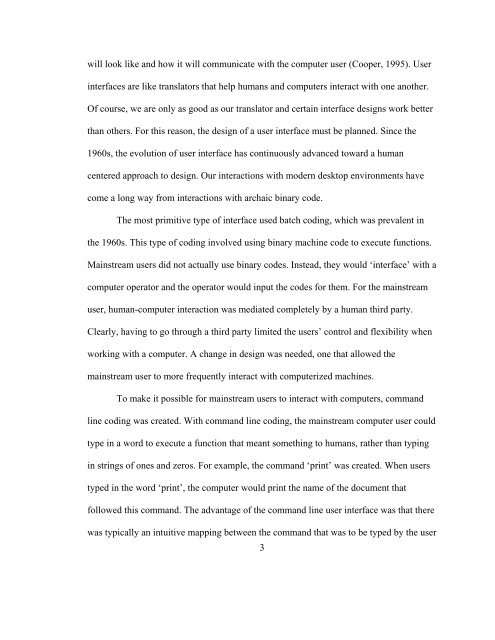The Use of Iambic Pentameter in the
The Use of Iambic Pentameter in the
The Use of Iambic Pentameter in the
Create successful ePaper yourself
Turn your PDF publications into a flip-book with our unique Google optimized e-Paper software.
will look like and how it will communicate with <strong>the</strong> computer user (Cooper, 1995). <strong>Use</strong>r<br />
<strong>in</strong>terfaces are like translators that help humans and computers <strong>in</strong>teract with one ano<strong>the</strong>r.<br />
Of course, we are only as good as our translator and certa<strong>in</strong> <strong>in</strong>terface designs work better<br />
than o<strong>the</strong>rs. For this reason, <strong>the</strong> design <strong>of</strong> a user <strong>in</strong>terface must be planned. S<strong>in</strong>ce <strong>the</strong><br />
1960s, <strong>the</strong> evolution <strong>of</strong> user <strong>in</strong>terface has cont<strong>in</strong>uously advanced toward a human<br />
centered approach to design. Our <strong>in</strong>teractions with modern desktop environments have<br />
come a long way from <strong>in</strong>teractions with archaic b<strong>in</strong>ary code.<br />
<strong>The</strong> most primitive type <strong>of</strong> <strong>in</strong>terface used batch cod<strong>in</strong>g, which was prevalent <strong>in</strong><br />
<strong>the</strong> 1960s. This type <strong>of</strong> cod<strong>in</strong>g <strong>in</strong>volved us<strong>in</strong>g b<strong>in</strong>ary mach<strong>in</strong>e code to execute functions.<br />
Ma<strong>in</strong>stream users did not actually use b<strong>in</strong>ary codes. Instead, <strong>the</strong>y would ‘<strong>in</strong>terface’ with a<br />
computer operator and <strong>the</strong> operator would <strong>in</strong>put <strong>the</strong> codes for <strong>the</strong>m. For <strong>the</strong> ma<strong>in</strong>stream<br />
user, human-computer <strong>in</strong>teraction was mediated completely by a human third party.<br />
Clearly, hav<strong>in</strong>g to go through a third party limited <strong>the</strong> users’ control and flexibility when<br />
work<strong>in</strong>g with a computer. A change <strong>in</strong> design was needed, one that allowed <strong>the</strong><br />
ma<strong>in</strong>stream user to more frequently <strong>in</strong>teract with computerized mach<strong>in</strong>es.<br />
To make it possible for ma<strong>in</strong>stream users to <strong>in</strong>teract with computers, command<br />
l<strong>in</strong>e cod<strong>in</strong>g was created. With command l<strong>in</strong>e cod<strong>in</strong>g, <strong>the</strong> ma<strong>in</strong>stream computer user could<br />
type <strong>in</strong> a word to execute a function that meant someth<strong>in</strong>g to humans, ra<strong>the</strong>r than typ<strong>in</strong>g<br />
<strong>in</strong> str<strong>in</strong>gs <strong>of</strong> ones and zeros. For example, <strong>the</strong> command ‘pr<strong>in</strong>t’ was created. When users<br />
typed <strong>in</strong> <strong>the</strong> word ‘pr<strong>in</strong>t’, <strong>the</strong> computer would pr<strong>in</strong>t <strong>the</strong> name <strong>of</strong> <strong>the</strong> document that<br />
followed this command. <strong>The</strong> advantage <strong>of</strong> <strong>the</strong> command l<strong>in</strong>e user <strong>in</strong>terface was that <strong>the</strong>re<br />
was typically an <strong>in</strong>tuitive mapp<strong>in</strong>g between <strong>the</strong> command that was to be typed by <strong>the</strong> user<br />
3

















